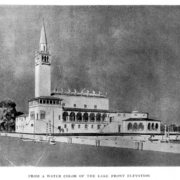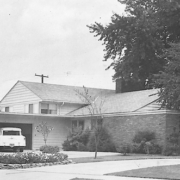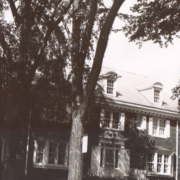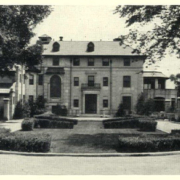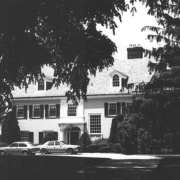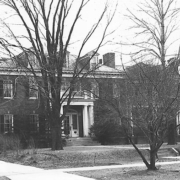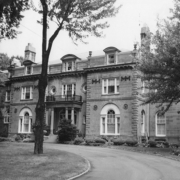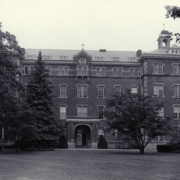Historical Architecture of Grosse Pointe – The Yacht Club 2
Last week we began our two-part feature on The Grosse Pointe Yacht. Part one focused on when the club was formed, the architect, and the costs associated with building the clubhouse. This week, we present the design of the club house, from the ornate exterior to the splendid Italian influenced interior.
As previously reported, the Grosse Pointe Yacht Club officially opened on July 4, 1929. The design for the clubhouse was started by renowned east coast architect Guy Lowell. However, after his untimely death, just 18 days after submitting initial sketches, the design was completed by two of Lowell’s senior associates Ralph Coolidge Henry and Henry P. Richmond. It is reported members of the club wanted a building that would be grander than anything along Lake St Clair and one that would compare with the two older clubs on Belle Isle (the Detroit Boat Club and the Detroit Yacht Club). Image courtesy of Wayne State University Digital Collections.

The Grosse Pointe Yacht Club, built by the Corrick Brothers, was unsurpassed by anything on the lake. The spectacular Italian-Renaissance style clubhouse welcomed members to what was one of the finest private clubs in the country. The exterior is dominated by the 187-foot campanile (an Italian bell tower), reportedly copied from that of St. Mark’s Cathedral in Venice. The structure is constructed of terra cotta hollow tile to which a bright rough-troweled sun-washed stucco was applied. The roof is variegated red-brown clay tile, while the architectural trim is stone. Some months after the completion of the club, the architect, Mr. Henry, wrote in an article for the architectural magazine Pencil Points (December 1929) – “The entire building (is given) a lighter and gayer atmosphere than typifies the more solidly mysterious prototypes of Venetian Romanesque and Gothic.” “Reflecting on the campanile it was at once apparent that the program demanded the informal and the picturesque in plan and that the composition required, for piquancy and flavor, some element of contrasting verticality in a region where all else is horizontal.” “The convincing first thought of an element to fulfill this function was of the campanile; why not one of slender proportions and marked height, with a large bell in its lantern to strike the hours and haIf hours of the dial-less ship’s clock; why not one whose height would be doubled by its reflection in the mirror of the calm water surface; why not one with a modern aviation beacon at its apex?” Images are courtesy of Pencil Points magazine (December 1929).
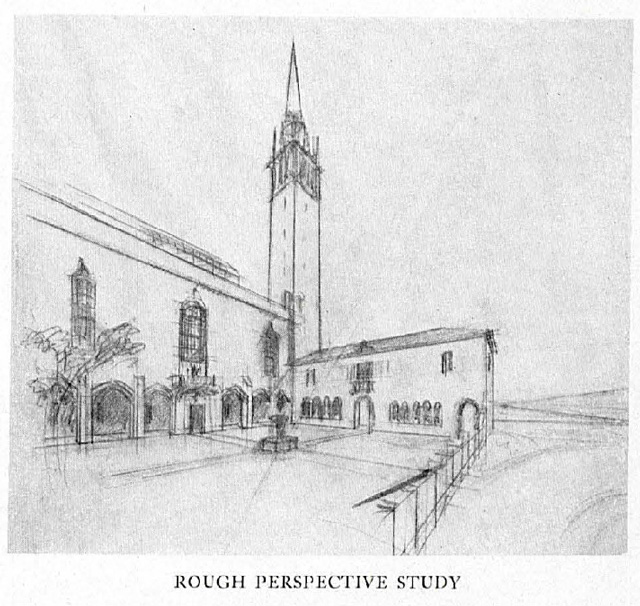
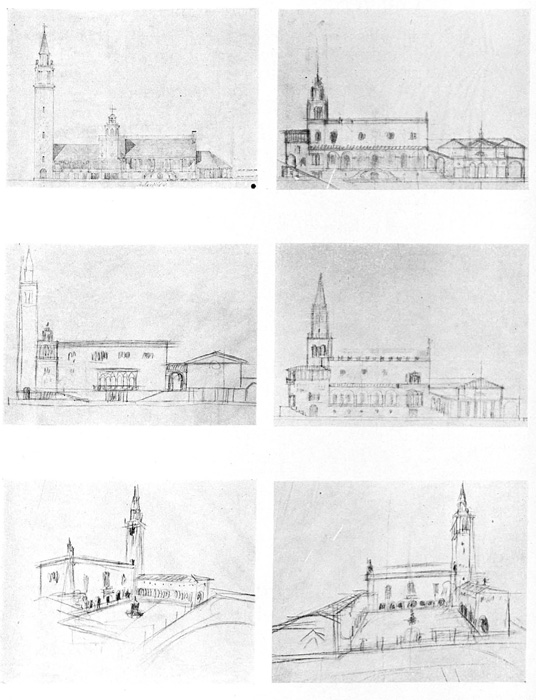
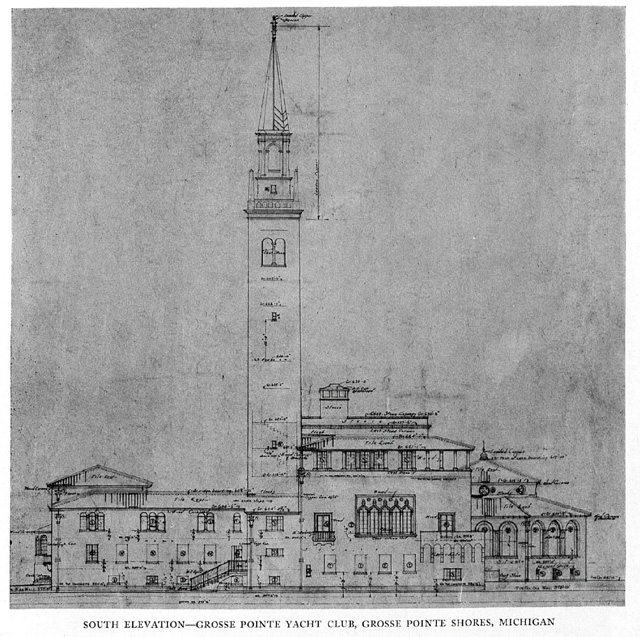
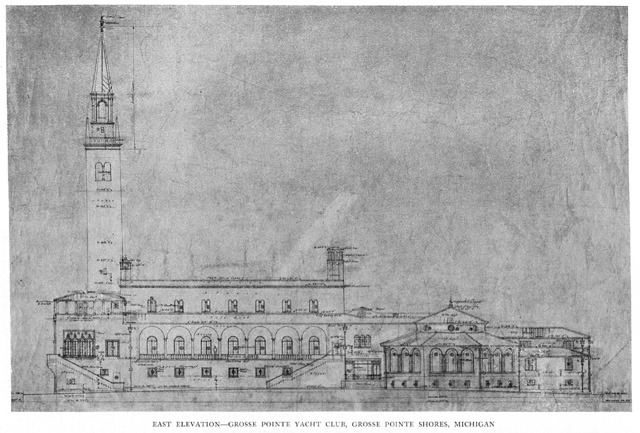
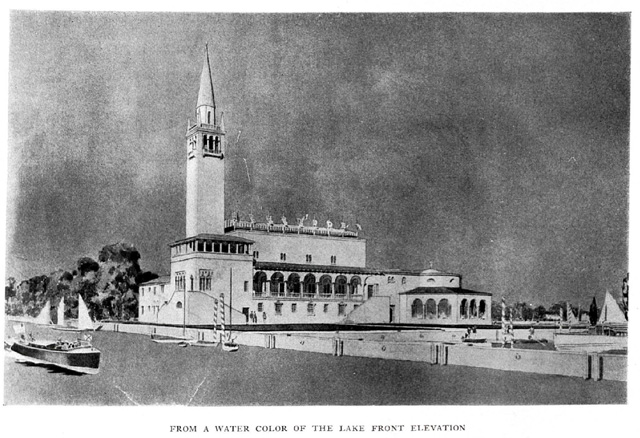
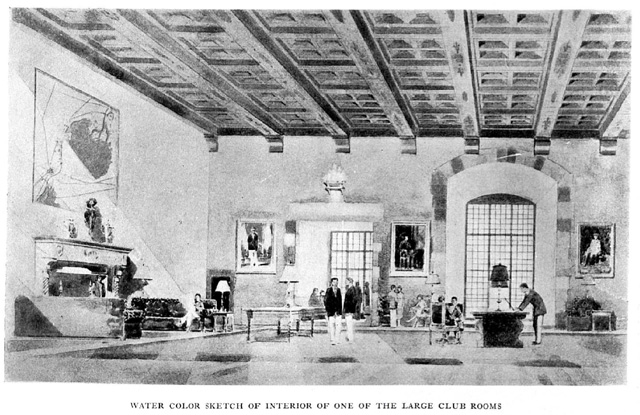
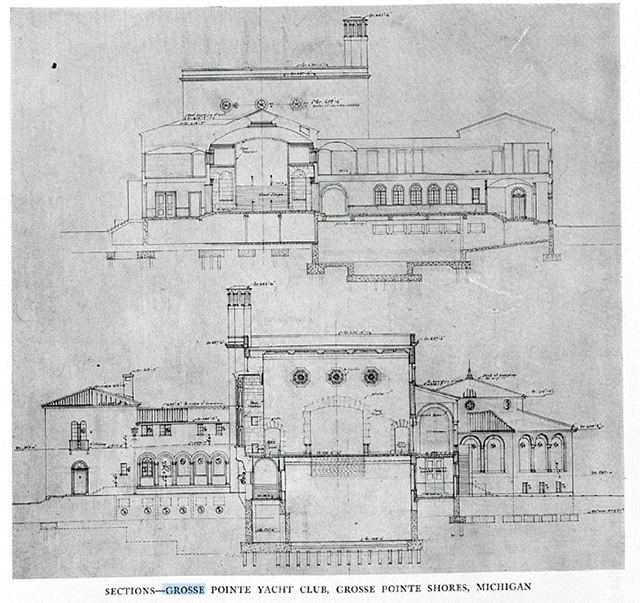
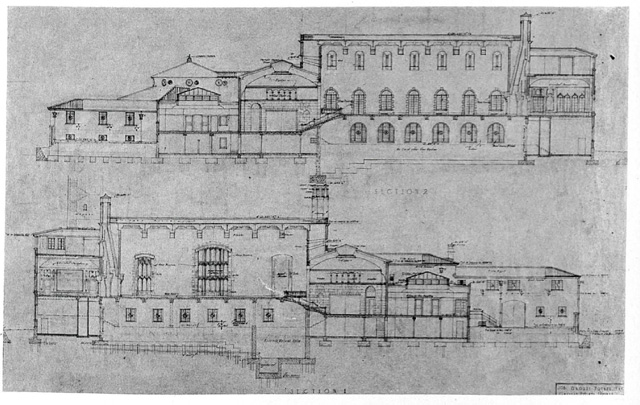
The design for the rear of the building originally featured a spacious Italian-styled veranda with a massive balustrade, pillars, and a vaulted ceiling of grey stone. The floor is laid with tan, orange, and green tile. It was a perfect space to enjoy fresh air and a view of the lake. It is the unique design of the club, coupled with the long driveway, Italianate gardens, and grand entrance (still in place today) that set the tone to what members and guests could expect to find inside. Image courtesy of Tonnancour, Volume 2.

Upon entering the clubhouse, members were greeted by the 50 feet long straight entrance foyer, furnished with is a 40-foot Oriental rug and Italian cabinets of old brown wood. Midway in the foyer is the 35-foot diameter Rotunda from which all other rooms could be accessed. This includes the largest room, the 86 ft long, 44 ft wide, and 29 feet high main clubroom. The room has seven arched French windows, leading to the veranda, while the far wall, comprised of three high Gothic bays, overlooks the Italian garden courtyard. The floor was polished oak for dancing, while the ceiling was timbered with girders, beams, and decorated plaster caissons of a rich weathered brown. An article in the Detroit Free Press (July 7, 1929) reports “the walls were finished in cream stucco, the wrought iron light fixtures were made in Italy especially for the club.” The furniture, some of which was imported from Italy, is copied from antiques. However, it is the Kadotastone trimmed fireplace, with a huge (10-foot x 20-foot) painting above it, that is the focal point of the room. It is reported the painting, by Guy Vining Smith a Boston artist, was a gift from Commodore John H. French on the Club’s opening, with the stipulation that it would hang in its place of honor. Source and image: Tonnancour Volume 2: A Beacon of Tradition: The Building of the Grosse Pointe Yacht Club.’ By James P. Gallagher.
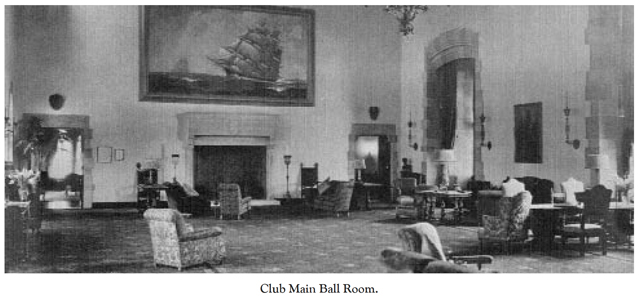
Moving onto the octagonal shaped main dining room, the 70 feet (in diameter) naturally lit room is spectacular. The article in Pencil Pointes (December 1929) describes “the central portion of the dining room is a vaulted clerestory supported on marble columns and decorated with frescoes of blue and old gold.” An article in the Detroit Free Press (July 1929) describes the fourteen large windows that look out over the lake, while the main colors and design of the room (walls and ceiling) are typical of Venice. The chandelier, in leaded red, amber, and clear glass, was made it Italy, while the walnut furniture is copied from pieces in Venice. It is also reported the room was originally planned for the seating of 250 dinner guests. In the club lounge, “the paneled walls were finished in soft greens, the Oriental rug was in tones of gold, and the draperies were of crimson silk damask.” “Much of the architecture and furniture in this room were in Louis XV style.” Source: Detroit Free Press. From the lounge a ladies’ wing, containing a library, and a room for bridge, could be accessed. Inside the director’s room, on the third floor, the small apartment contained furniture that was covered with blue, tan, and red leather, with an Oriental rug on the floor. Image courtesy of Wayne State University Digital Collections and Tonnancour, Volume 2.
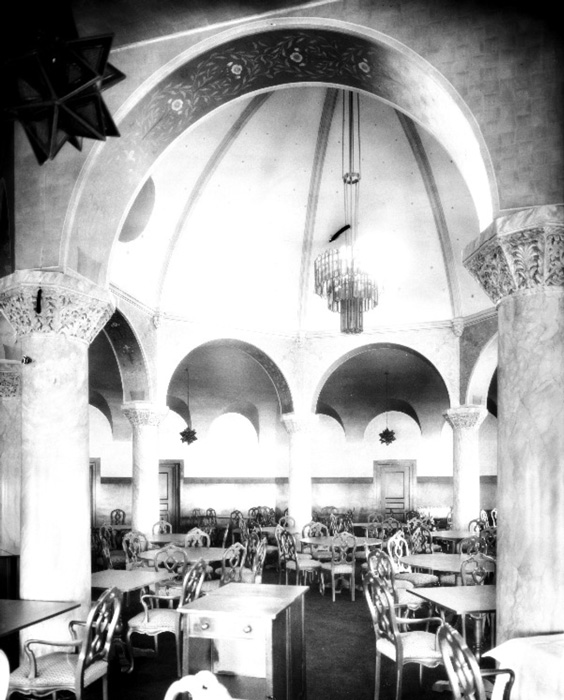

The Pencil Points article describes how “on the ground floor adjoining the main entrance foyer, under the main clubroom, is a modern swimming pool compartment with its solarium and a locker-room and bathroom wing.” “The solarium is so related to the swimming room chamber itself that all the swimming may be viewed in temperature conditions comfortable for those in street clothes, the dividing partition between the two being glazed and insulated so that the bathers themselves may have a higher temperature and humidity.” “It is not possible to enter the swimming pool compartment in street costume, and all precautions have been taken to maintain those other sanitary conditions which are the attributes of all up-to-date swimming pool equipment.” Image courtesy of Wayne State University Digital Collections.
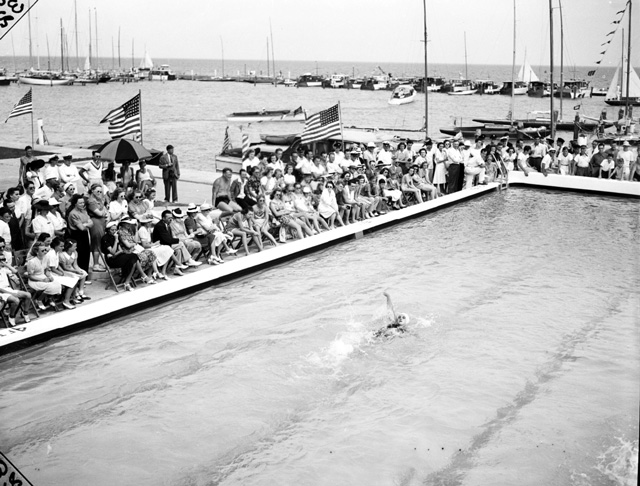
Following the struggles with the Great Depression and having the bank foreclose, the club was eventually purchased back (from the creditors) by a new group of officers. As the economy continued to recover so did the number of members, as did the number of people interested in boating. The Yacht Club was “re-born”. Over the years the Grosse Pointe Yacht Club has undergone numerous changes and renovations. During the late 1940’s bowling alleys were installed on the lower level, and the south harbor was created. Throughout the 1980’ and 90’s the club underwent significant transformation – the kitchen was doubled in size, the Spinnaker Room was expanded and remodeled, the entrance foyer was refurbished, while the veranda was enclosed, remodeled, and renamed the Binnacle – the Club’s lakeside dining area. Source and image: Tonnancour Volume 2: A Beacon of Tradition: The Building of the Grosse Pointe Yacht Club.’ By James P. Gallagher.
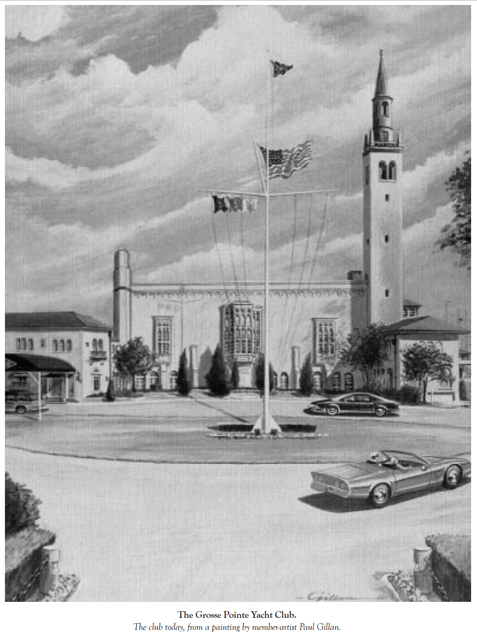
On the whole, the Grosse Pointe Yacht Club remains the same as it did when it opened its doors to members on July 4, 1929 – not only in terms of the historical architecture, but as a welcoming symbol on the lake, loved and treasured by its members and the community.
*Photos courtesy of the Higbie Maxon Agney archives unless stated.
** Research, information, and data sources are deemed reliable, but accuracy cannot be fully guaranteed.
Written by Katie Doelle
Copyright © 2023 Katie Doelle

